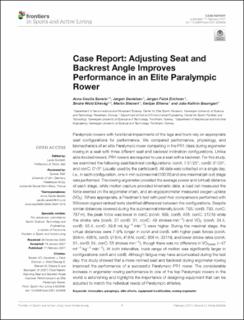| dc.description.abstract | Paralympic rowers with functional impairments of the legs and trunk rely on appropriate seat configurations for performance. We compared performance, physiology, and biomechanics of an elite Paralympic rower competing in the PR1 class during ergometer rowing in a seat with three different seat and backrest inclination configurations. Unlike able-bodied rowers, PR1 rowers are required to use a seat with a backrest. For this study, we examined the following seat/backrest configurations: conA: 7.5°/25°, conB: 0°/25°, and conC: 0°/5° (usually used by the participant). All data was collected on a single day, i.e., in each configuration, one 4-min submaximal (100 W) and one maximal (all-out) stage was performed. The rowing ergometer provided the average power and (virtual) distance of each stage, while motion capture provided kinematic data, a load cell measured the force exerted on the ergometer chain, and an ergospirometer measured oxygen uptake (V˙O2). Where appropriate, a Friedman's test with post-hoc comparisons performed with Wilcoxon signed-ranked tests identified differences between the configurations. Despite similar distances covered during the submaximal intensity (conA: 793, conB: 793, conC: 787 m), the peak force was lower in conC (conA: 509, conB: 458, conC: 312 N) while the stroke rate (conA: 27 conB: 31, conC: 49 strokes·min−1) and V˙O2 (conA: 34.4, conB: 35.4, conC: 39.6 mL·kg−1·min−1) were higher. During the maximal stage, the virtual distances were 7–9% longer in conA and conB, with higher peak forces (conA: 934 m, 408 N, conB: 918 m, 418 N, conC: 856 m, 331 N), and lower stroke rates (conA: 51, conB: 54, conC: 56 strokes·min−1), though there was no difference in V˙O2peak (~47 ml−1·kg−1·min−1). At both intensities, trunk range of motion was significantly larger in configurations conA and conB. Although fatigue may have accumulated during the test day, this study showed that a more inclined seat and backrest during ergometer rowing improved the performance of a successful Paralympic PR1 rower. The considerable increase in ergometer rowing performance in one of the top Paralympic rowers in the world is astonishing and highlights the importance of designing equipment that can be adjusted to match the individual needs of Paralympic athletes. | en_US |

